AMERICAN SILVERPLATE MARKS
MARKS AND HALLMARKS OF USA AND CANADA SILVER PLATE MAKERS |
The two common forms of plated silver are Sheffield plate and silverplate/electroplate.
Sheffield Plate is a cheaper substitute for sterling, produced by fusing sheets of silver to the top and
bottom of a sheet of copper or base metal. This 'silver sandwich' was then worked into finished pieces. At
first it was only put on one side and later was on top and bottom.
Modern electroplating was invented by Italian chemist Luigi V. Brugnatelli in 1805. Brugnatelli used his
colleague Alessandro Volta's invention of five years earlier, the voltaic pile, to facilitate the first
electrodeposition. Unfortunately, Brugnatelli's inventions were repressed by the French Academy of Sciences
and did not become used in general industry for the following thirty years.
Silver plate or electroplate is formed when a thin layer of pure or sterling silver is deposited
electrolytically on the surface of a base metal.
By 1839, scientists in Britain and Russia had independently devised metal deposition processes similar to
Brugnatelli's for the copper electroplating of printing press plates.
Soon after, John Wright of Birmingham, England, discovered that potassium cyanide was a suitable
electrolyte for gold and silver electroplating.
Wright's associates, George Elkington and Henry Elkington were awarded the first patents for electroplating
in 1840. These two then founded the electroplating industry in Birmingham England from where it spread
around the world.
Common base metals include copper, brass, nickel silver—an alloy of copper, zinc and nickel—and Britannia
metal-a tin alloy with 5–10% antimony. Electroplated materials are often stamped EPNS for electroplated
nickel or silver, or EPBM for electroplated Britannia metal.
Sheffield plate by the fusion process was not made in America, but factories here did turn out quantities of
electroplated silver. In fact, it was so popular that one English firm with several variations of its name,
but all including Dixon, sold quantities of electroplated silver, issued catalogues, and even had a New York
showroom.
Today there is a great deal of American plated silver which has been treasured for years. Many families had
plated silver as well as fine sterling. Some of it was inherited; some prized for sentimental reasons.
If you have this plated ware, and it is as dear to you as fine early silver, then you are among the happy
people of this world.
On plated silver the terms 'triple' and 'quadruple' indicate the number of coatings received by the base
metal in the electroplating process. Naturally the more metal used in the plating the longer the piece
should last. Polishing and wear have taken their toll of much of this plated ware and whether pieces are
worth replating depends on their usefulness and your pleasure in them. If you like them well enough to
spend money on them, then by all means have the work done, but remember a piece is worth at market value
only the metal that is in it, the base metal under the plating being worth very little.
 |
Adelphi Silver Plate Co - New York
First record 1890 |
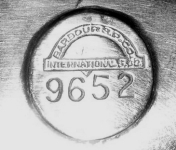 |
Barbour Silver Co - Hartford CT
Part of International Silver Co.in 1898 |
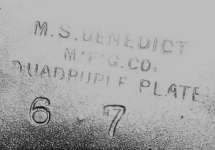 |
Benedict MFG. Co. East Syracuse New York
active in 1894, out of business in 1953 |
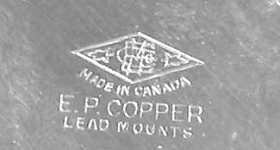 |
Benedict- Proctor MFG - Trenton Ontario - Canada
a branch of Benedict MFG established about 1910, out of business in 1970 |
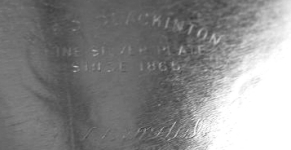 |
W. & S. Blackinton Co. - Meriden CT
founded in 1865. Purchased by Raimond Silver Mfg. Co in 1966 |
 |
Continental Silver Co. - New York
c. 1920 to 1950 |
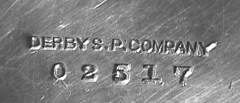
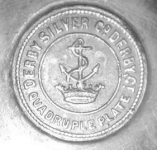 |
Derby Silver Co. - Derby (Birmingham) CT
founded in 1873. Consolidated into Meriden in 1933 |
E.P.N.S. (Electroplated Nickel Silver) and EPBM (Electroplated Britannia Metal) are the most
common names attributed to silver plate items. But many other names are used for silver plate:
EPWM - Electroplate on White Metal, EPC - Electroplate on Copper, Argentium Argentine Plate, Argentum,
Ascetic B. B. S. Ltd, Ashberry, Austrian Silver, Brazilian Silver D&A Trademark of Daniel and Arter,
Buxbridge - Trademark name of JT&Co., Electrum, Encore TT&Co Trademark of T. Turner, Exquisite,
HH&S , I.XL Geo. Wostenholm & Son, Insignia Plate, JB&S EP A1, JD&S = John Dixon & Sons,
K & TL , M&W Mappin and Webb, N.S. New Silver, Nevada Silver D&A Trademark of Daniel and Arter,
Norwegian Silver; Trademark of WG&S, Pelican Silver JGNS, Potosi Silver N&S WP, RN&S EP Neill,
Silverite = Trademark of W P & Co , Sonora Silver = Trademark of Walker and Hall, Spur Silver =
Trademark of E B & Co for Edwin Blyde & Co, Stainless N. S., Stainless Nickel, Stainless Nickel
Silver, Venetian Silver - Trademark of Deykin & Sons, WF&SS EP
This is a page of Silvercollection.it "A Small Collection of
Antique Silver and Objects of vertu",
a 1000 pages widely illustrated website offering all you wish to know about
antique silver, sterling silver, silverplate, sheffield plate, electroplate silver,
silverware, flatware, tea services and tea complements, marks and hallmarks, articles,
books, auction catalogs, famous silversmiths (Tiffany, Gorham, Jensen, Elkington),
history, oddities ...
SITE MAP -
SILVER DICTIONARY |
|
work in progress on this page - your help, corrections and suggestions will be greatly appreciated -
|
